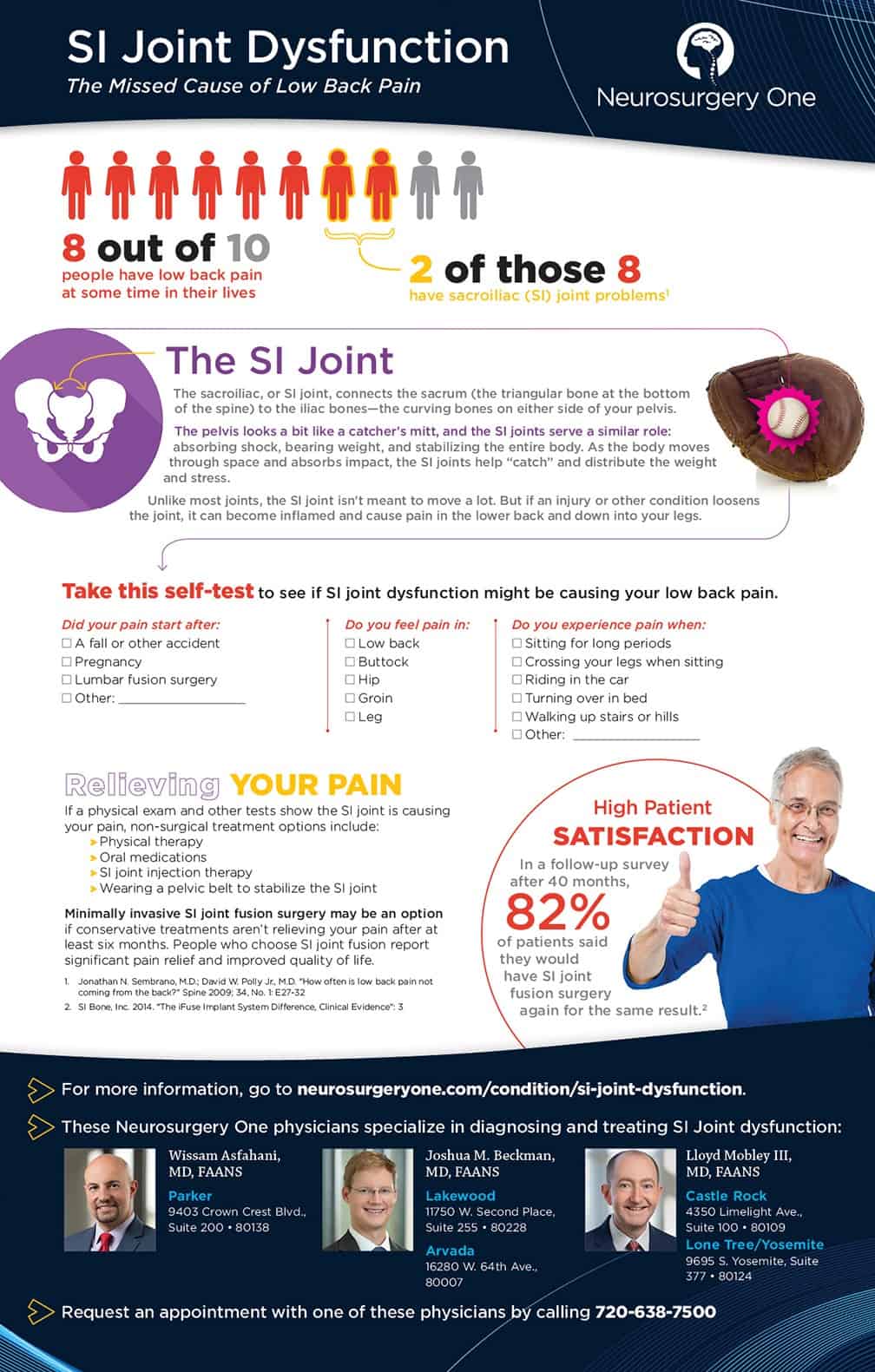If you suspect your SI joint might be the cause of your lower back pain, a simple SI joint dysfunction self test can help you decide if its time to see a spine specialist.
SI joint is short for sacroiliac joint. This is the joint that connects the lowest portion of your spine, the sacrum, to your hip bones, the ilium. While most people think of joints as connections that allow motion, a healthy SI joint actually moves very little–only about 2 to 4 mm in any direction. The primary functions of your SI joint are to stabilize your body and to act as a shock absorber by bearing the weight of your upper body.
SI joint pain, also called SI joint dysfunction, is often experienced as low back pain. Many physicians and spine surgeons are not trained to look for SI joint dysfunction as a cause for lower back pain. And imaging, such as an MRI, usually does not extend into the pelvis. For these reasons, SI joint dysfunction is often misdiagnosed as a spine problem. But there are some simple ways for you and your doctor to tell if your low back pain might be due to SI joint dysfunction. Download the infographic below to learn more and take a quick SI joint dysfunction self test. If these questions point toward SI joint dysfunction as a possible cause, you should be evaluated by a spine specialist with experience in diagnosing and treating the condition.
[Click on the image above to download the SI Joint Dysfunction Self Test [Infographic]
Diagnosing SI Joint Dysfunction
If you take an SI joint dysfunction self test and believe this is causing your low back pain, what’s next? You should see a neurosurgeon or spine surgeon who specializes in recognizing, diagnosing, and treating SI joint dysfunction. When you see an SI specialist, take a record of your symptoms (SI Joint Form for Your Doctor) with you. If you live in the Denver area, Neurosurgery One has Denver spine surgeons who specialize in SI joint dysfunction.
During your appointment, the spine specialist will perform a physical exam and apply light pressure to your hips, knees, and other areas to see which positions may cause discomfort or pain. These are called “provocative” tests because the physician is trying to provoke a response that indicates a problem with your sacroiliac joint. In addition, the spine surgeon also will order imaging tests, most likely an MRI or CT scan, if you haven’t already obtained one. The final step in confirming a diagnosis is to inject pain relief medication into your SI joint. At Neurosurgery One, we use x-ray guided spinal injections and we perform these with the patient sedated to avoid pain during the injection.
If your pain is relieved by at least 50 percent, then you will most likely be diagnosed with SI joint dysfunction and your spine surgeon will discuss a treatment plan with you.
Relieving SI Joint Dysfunction Pain
Like most cases of back pain, SI joint dysfunction is treated with conservative, non-surgical treatments first. These include physical therapy and home exercises, over-the-counter pain medications (such as ibuprofen), and SI joint injections such as the one used to diagnose the condition. It may take up to six months for your pain to go away, so you should be sure to continue the exercises and other treatments recommended by your physician.
If you are still experiencing back pain or leg pain after six months of conservative treatment, your spine surgeon may discuss SI joint fusion with you. SI joint fusion helps stabilize the joint. This reduces the movement that causes friction and the inflammation causing your pain. At Neurosurgery One, we perform minimally invasive SI joint fusion. During this procedure, the spine surgeon makes a small incision on the side of the buttocks to reach your joint. The surgeon then places small titanium implants across the joint, which limit the movement.
Watch a video of how the SI joint fusion procedure is performed.
Neurosurgery One’s Denver spine surgeons perform most SI joint fusion procedures in ambulatory surgery centers on an outpatient basis. The procedure takes about an hour in the operating room, and you will be sedated through it. Patients go home the same day. Depending on what type of work you do, you may be able to go back to work in one to two weeks for desk jobs although it could be up to three months if you have a strenuous job such as in construction. People who have had SI joint fusion report significant pain relief and improved quality of life, with greater than 80 percent patient satisfaction.
If you would like to learn more about SI joint dysfunction, visit these pages:
If you would like to schedule an appointment with a Denver spine surgeon at Neurosurgery One, you can request an appointment online or call 720.638.7500 to schedule.






